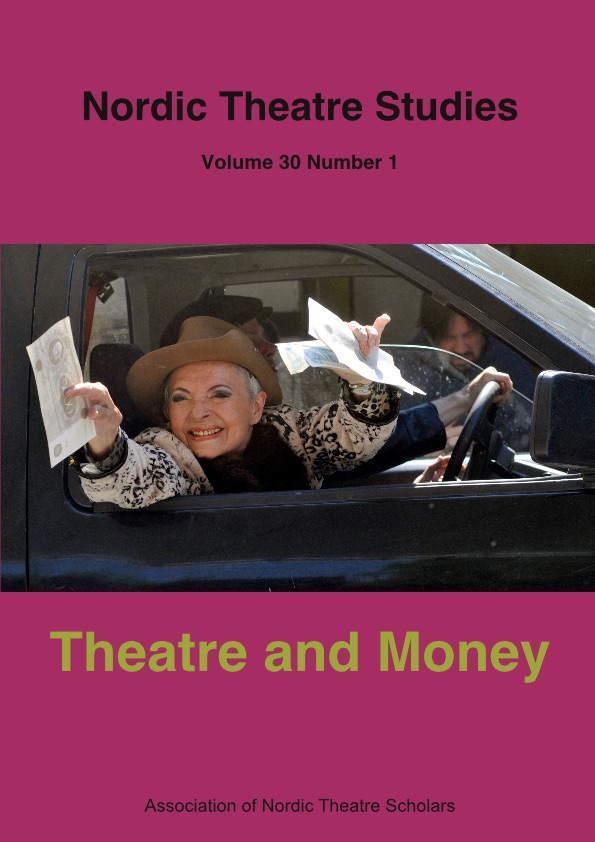From Institutional Fatigue to Creative Communication
Audience Development in Lithuanian Theatres
DOI:
https://doi.org/10.7146/nts.v30i1.106924Keywords:
Audience development, audience research, Lithuanian theatre, public theatres, participatory cultureAbstract
A considerable decreasing number of visitors to artistic and cultural institutions, which in certain European countries has dropped 50%, the unfavourable demographic situation, receding public finances, the growing competitive ability of user-oriented, interactive entertainment industries, and the new technology sector, which is especially disturbing for artistic institutions in post-Soviet countries, where they are used to limit competition – these are the major issues that are forcing the decision makers of cultural politics to focus their attention on art audiences at the topmost institutional level. In the context of these transformations, the concept of audience development, denominated by Nobuko Kawashima “a conflicting term” almost two decades ago, is becoming even more complex. Placed at the centre of the political and financial agenda of the European Union (EU) by its cultural policy makers, it is, on the one hand, born out of the desire to place part of the financial burden of support for cultural institutions on the shoulders of the public, but on the other hand, it also signals the wish to shake up the passive European citizen, to activate his/her civic sense through artistic practices, or even to help “combat social exclusion”. The article focuses on the theoretical and practical implications as well as the effectiveness and limitations of various forms of audience development employed by publicly funded theatres in Lithuania. Empirical research is based on qualitative interviews with managers and art directors of Lithuanian theatre companies as well as focus group audience research. The larger questions about the possible outcomes of various audience development strategies – whether during these developments, Lithuanian theatres will become places of creative cooperation open to diverse audiences or simply fields of aggressive marketing – will be addressed as well.
References
Bamford, Anne and Michael Wimmer. 2012. Audience Building and the Future Creative Europe Programme. European Expert Network on Culture (EENC) Short Report.
Bjørnsen, Egil. 2014. “The Limitations of Audience Development”. Audiences Norway 2014. http://www.nordicperformingartsdays.fo/wpcontent/uploads/2014/06/Publikumsutviklingens-begrensninger-engelsk-versjon.pdf.
Boorsma, Miranda. 2006. “A Strategic Logic for Arts Marketing: Integrating Customer Value and Artistic Objectives”. International Journal of Cultural Policy, 2006, 12:1.
Burovienė, Agnė. Interview 20 Sept 2013.
Butsch, Richard. 2000. The Making of American Audiences, Cambridge: Cambridge University Press.
Butsch, Richard. 2008.The Citizen Audience. Crowds, Publics, and Individuals. London: Routledge.
Danielsen, Arild. 2008. “The Persistence of Cultural Divides – Reflections on the Audience for Culture and the Arts in Norway”. International Journal of Cultural Policy, 2008, 14:1, 95–112. http://dramosteatras.lt/teatro-uzkulisiai/ (10 March 2015)
European Commission opens call for tenders for study on audience development. http://www.creativeeuropeuk.eu/Audience%20Development%20tender
(16 June 2015)
Guidelines of the Lithuanian Cultural Policy, Vilnius: 2010. https://e-seimas.lrs.lt/portal/legalAct/lt/TAD/TAIS.377620.
Glow, Hillary. 2013. “Challenging Cultural Authority: A Case Study in Participative Audience Engagement.” In The Audience Experience: a Critical Analysis of Audiences in the Performing Arts, University of Chicago Press, Chicago 2013
Hand, Chris 2002. ”Do Arts Audiences Act like Consumers?” Managing Leisure, 2011, 16:2, 88–97.
Hayes, Debi and Alix Slater. 2002. “Rethinking the missionary position – the Quest for Sustainable Audience Development Strategies”. Managing Leisure, 2002, 7, 2–5.
Harvie, Jen. 2014. Fair Play: Art, Performance and Neoliberalism. London: Palgrave Macmillan.
Hutton, Lucy, Ann Bridgwood and Karen Dust. 2004. “Research at Arts Council England”. Cultural Trends, 2004, 13:4, 41–64.
Kawashima, Nobuko. 2000. Beyond the Division of Attenders vs. Non-attenders : a Study into Audience Development in Policy and Practice. Working Paper, Coventry: University of Warwick, Research papers, Vol.6.
Kazlienė, Rima. Interview 20 Sept 2013.
Keaney, Emily. 2008. “Understanding Arts Audiences: Existing Data and What it Tells us”. Cultural Trends, 2008, 17:2, 97–113.
Kiznienė, “Aura” Edita. Interview 13 May 2013.
Klaić, Dragan. 2008. ”Teminiai prioritetai, nustatytos tipologijos keitimas”. Kultūros politika. Vilnius: Baltos lankos.
Law on Theatre and Concert Institutions of the Lithuanian Republic, Vilnius: 2016.
https://www.e-tar.lt/portal/lt/legalAct/276fcbf0860711e6b969d7ae07280e89.
Medzevičius, Donatas. Interview 20 Sept 2013.
Petrauskienė, Vita. Interview 24 May 2013.
Policies and Good Practices in the Public Arts and in Cultural Institutions to Promote Better Access to and Wider Participation in Culture, October, 2012. http://ec.europa.eu/culture/events/documents/workplan-2011-14.pdf (30 March 2017).
Rancière, Jacques. 2009. The Emancipated Spectator. London and New York: Verso.
Research and Guidelines of Modernisation of the System of Drama Theatres in Lithuania, Teatro ir kino informacijos ir edukacijos centras, Vilnius. 2010, 18.
http://www.theatre.lt/TEATRU_TYRIMAS.pdf (30 Sept 2016).
Smith, Rachel A. 2012. “Segmenting an Audience into the Own, the Wise, and Normals: A Latent Class Analysis of Stigma-Related Categories”. Communication Research Reports, 2012, 29:4, 257–265.
Stancikas, Egidijus. 2016. Self-Education of Adult Drama Theatre Spectators’ Cultural Awareness. Kaunas: Vytautas Magnus University.
Survey of Participation of the Population in Culture and Satisfaction with Cultural Services [Gyventojų dalyvavimo kultūroje ir pasitenkinimo kultūros paslaugomis tyrimo ataskaita], LR Kultūros ministerija, UAB „Socialinės informacijos centras“ ir UAB Vilnius: 2014. http://www.lrkm.lt/index.php?971888529 (20 Oct 2016)
Udrienė, Laura. Interview 20 Sept 2013.
Zakaras, Laura and Julia F. Lowell. 2008. Cultivating Demand for the Arts. Arts Learning, Art Engagement, and State Art Policy. Santa Monica: RAND (Research in the Arts), The Wallace Foundation.
Downloads
Published
How to Cite
Issue
Section
License
The copyright belongs to the authors and Nordic Theatre Studies. Users can use, reuse and build upon the material published in the journal but only for non-commercial purposes. Users are allowed to link to the files, download the files, distribute the files on a local network (preferably by links), upload the files to local repositories if their institutions require them to do so, but not republish the files without proper agreements with the journal and the author.

